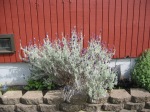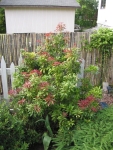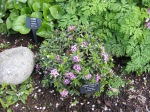Oregon Green Pine/Pinus nigra “Oregon Green” – now
I just came in from my usual morning stroll thru the garden. It was a bit damp with a slight drizzle. I particularly like to walk in the garden when it’s all wet. The plants feel incredibly alive! The rainfall is so nourishing. It seems like all the plants are rejoicing. Walking in the garden got me all excited about it so I thought it was a good time to do my next post of miscellaneous photos. Most are very recent but a few are from Fall or Winter. I’ll tell you.
I already showed you a photo of this pine from the front so you could see the candles on the outside. This is the inside. I pruned it out in February. My main goal was to open up the center for both sight and air circulation. I also just felt it was a little crowded inside. It felt like the energy wasn’t moving thru it properly. I tried to bring out the inner “flow” to it. It all radiates out from the main trunk now. The tree has done most of this itself. I pruned out the inner part but the tree itself created the sinuous form. You can’t see it in the photo but it continues to twist and turn as it reaches the top.
3 Fabulous Ferns – now
This is the west end of the fern bed that runs along the north side of the garage. The 3 ferns here are, from left to right, a Hard Shied Fern (Polystichum aculeatum), and Mackino’s Holly Fern (Polystichum mackinoi” and a Remote Wood Fern (Dryopteris remota). Underneath them all is a wonderful patch of Baby Tears (Soleirolia soleirolii). I’ve loved this little plant since we had it growing at my parent’s home in the first landscape I ever did for them. It brings back good memories.
 Tomato Seedlings In the Greenhouse – April
Tomato Seedlings In the Greenhouse – April
I started 9 seeds each of 3 different heirloom varieties. 2 I bought form the Seed Saver’s Exchange, a seed bank/seller I recommend highly. The other one I planted with seeds I grew last year. Beam’s Yellow Pears. Small sweet pear shape yellow fruits kids eat like candy, and so do adults… These were so well developed we could plant them in early May. They’re good sized now. I had way too many of course – I only planted 2 of each variety for us. So I put the others out on the front parking strip and people took them almost immediately. I love sharing the plants I grow.
Silver Knight Scotch Heather/Calluna vulgaris “Silver Knight” – now
This lovely little heather is at the foot of our front steps. In late summer it’s covered with light lavender blooms, but I planted it more for the foliage and form than the flower, since that’s what we see most of the year. We planted it about 5 years ago.
Tenzan Sugi/Cryptomeria japonica “Tenzan” – now
This is the one plant in the garden that I can say with surety is a truly rare plant. The nursery where I bought it labeled it as such and my reading confirms this to be true. It’s the smallest form of Cryptomeria there is and valued as such. Brand new here. It only grows about 1/4″ a year. It’s supposed to get about a foot big. It’s only 8″ now. It’ll take it years to do that.
Charity Mahonia/Mahonia media “Charity” – now
This one has been here about 9 years. In that time it’s grown to 12′ x 10′, give or take. It’s a prickly thing so I had to prune it back quite a bit from the path at its foot. I pruned up the branches but this year it’s putting back all the foliage I cut off! Only it’s further back from the front so I won’t have to mess with it, and it won’t mess with us. I did a post awhile back called Hummer Heaven that shows this in full bloom, covered with brilliant yellow flowers that the bees and hummers love. On the left below it is a Soft Shield Fern (Polystichum setiferum), also known as Alaska Fern, tho it’s native to Europe. Go figure.
Graciosa Hinoki False Cypress/Chamaecyparis obtusa “Graciosa” – now
I took this photo from the porch above this plant so you could see the delicate tracery on its branches. We planted this tree just last year after the snow destroyed the big Arborvitae we had here. It grows slowly at less than a foot a year. It’ll get 10′ tall and 8′ wide. It fits nicely among the rhododendrons, azaleas and kinnickinnick, under the Japanese maple at the right.
Waterfall Dissected Japanese Maple/Acer palmatum dissectum “Waterfall” – now
It does look a bit like a waterfall doesn’t it. The way the leaves overlap one another resembles water flowing down over it. This tree has been growing here since 2013. It’s grown from 2′ across to over 8′. It’s supposed to get even bigger, so I have to prune it back from the lawn every spring. It puts on 2′ of growth a year so it’s a bit of a job. It gets harder every year.
Firefly Scotch Heather/Calluna vulgaris “Firefly” – Fall
This is one of the most colorful heathers there is. In summer it’s orangish green, but the real show is in fall and winter when it turns this deep brick red. We planted a line of them along the North side of our veggie garden. It was too weird to watch the South side of the plants turn this great red color, but from the North side, where we stand to look at them, you can’t even tell the South side is red. Shows you how important it is for plants to get sun, and at the right time, to turn color in fall.
Lady Fern/Athyrium filix-femina – now
This lovely fern is a native of the Pacific Northwest. We never plant them but they come up all over the garden, often in perfect places like this one. It’s a deciduous fern so it dies back to the ground in fall. This one is over 5′ tall and got that way because it was growing behind a large Arborvitae that supported it. Now it tends to flop on the rhodies in front of it.
Bloodgood Japanese Maple/Acer palmatum atropurpureum “Bloodgood” – now
This maple is in the middle of the garden. When you look at it all from the back deck it really stands out. It’s been here for 8 years, and is now 14 1/2′ x 11′. It will eventually get large enough to fill the space it inhabits now. I’ll have to do some pruning as the years go by to encourage the trees to all fit together, as I do so often. In fall this tree gets much darker red, almost black and burgundy and is truly stunning. It’s big enough now to feel like it’s a real tree when you’re underneath it.
Primo Eastern Arborvitae/Thuja occidentalis “Isl/Prm Primo” – now
We just got this cute little thing this last winter. When we bought it it was a darkish brown color. Now it’s this lovely dark green. I love how the branches grow upward like some stone formations I’ve seen in the terrain of the inner mountain west. But this is actually from the east coast and has the same parent as the ubiquitous Pyrimidal Arborviate, the columnar tree grown so frequently as a tall fast growing hedge. By contrast “Primo” only grows an inch a year, if that.
OK, that’s another batch. I may only have one more set, but I have to count them to see. I may add a few more too, if I see some more I like. I keep taking photos so you never know. I’m really enjoying this casual flowing show of photos. It’s so much easier to just post them and write a bit about them. I don’t have to have an overarching theme to follow. But I imagine I’ll get back to that format now that I’m feeling somewhat caught up.
This blog is partly a chronicle of the timeline of the plants in this garden, so I have to keep posting their pictures as they grow up. I’ve taken over 9,000 photos of this garden so I never lack for subjects to post. It’s so interesting to me to show them as they’ve grown. It’s very educational, and lots of fun. I’ve learned a lot growing this garden. Skills I use in my daily life – Patience being the biggest one I suppose. You absolutely have to be patient to be a gardener (and I have to work at it). Plants grow on their own schedules, not ours. The same is true of life.
Acceptance that it is what it is, is the key.
Steve










































































































































